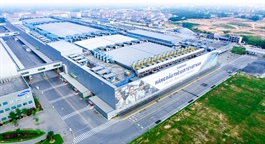Efforts to overcome pandemic obstacles
Efforts to overcome pandemic obstacles
The Vietnam Leather, Footwear and Handbag Association has proposed that enterprises resume operations as soon as the Covid-19 pandemic is brought under control.

Enterprises need to resume operations as soon as the Covid-19 pandemic is brought under control
|
Maintaining growth
The export value of Vietnam’s leather and footwear sector reached US$14.2 billion in the first seven months of 2021, an increase of 25.3 percent compared to a year ago. According to the Vietnam Leather, Footwear and Handbag Association, Vietnam’s leather and footwear exports have benefitted from the tariff reduction commitments under the EU-Vietnam Free Trade Agreement (EVFTA), as a result of which EU orders from footwear producing countries in South Asia and Southeast Asia (India, Bangladesh, Indonesia, the Philippines, Cambodia and Myanmar) have been shifting to Vietnam. Domestic enterprises have already signed orders until the end of the year and with its growth momentum, Vietnam’s leather and footwear exports are expected to reach US$23 billion this year, a year-on-year increase of 15-16 percent.
However, the resurgence of Covid-19 has hit Vietnam’s southern provinces, especially Binh Duong and Kien Giang, where many large leather and footwear enterprises are located. As a result, leather and footwear enterprises are short of workers and cannot recruit more workers due to social distancing and travel restrictions. In addition, there is a serious shortage of containers for exports, while costs of logistics and international shipping and of imported raw materials remain high.
To overcome these difficulties, the association recommended that enterprises optimize production costs, trim operating costs, and make good use of free trade agreements, especially the Comprehensive and Progressive Agreement for Trans-Pacific Partnership (CPTPP) and the EVFTA. They must also pay special attention to Covid-19 prevention measures to ensure safe production.

Workers are among the priority groups for vaccination
|
Facilitating production and business
Enterprises in Ho Chi Minh City and other southern provinces have spent billions of Vietnamese dong to implement the “3 on-site” model - working, eating and sleeping at the worksite. However, the model has increased costs significantly because employers need to pay for worker accommodations and meals.
Phan Thi Thanh Xuan, deputy chair of the Vietnam Leather, Footwear and Handbag Association, said leather and footwear is a labor-intensive industry and therefore the “3 on-site” model is not appropriate. She advised applying a “2 on-site” model (eating and working) coupled with rapid testing.
Under that model, workers would be allowed to go home as long as they are committed to staying either at their house or at work. Enterprises will be responsible for confirming workers’ route and location, while increasing the frequency of rapid testing to ensure new Covid-19 cases are treated quickly. Local authorities need to join forces in ensuring that workers do not leave their homes and provide specific instructions on the expected roadmap to resume production.
Xuan added that state management agencies should provide guidelines on responses to the detection of new Covid-19 cases so that manufacturing can continue. Worker vaccination would also help enterprises resume production but most are still waiting.
The Vietnam Industry Agency under the Ministry of Industry and Trade proposed a number of policies to support enterprises. Accordingly, the State Bank of Vietnam should provide credit institutions with guidelines to increase credit limits, which are no longer sufficient given the increased costs of imported raw materials.
| The Vietnam Industry Agency suggested state management agencies and localities speed up the simplification of administrative procedures for the circulation and transportation of goods. |



























